The Ones Who
Watch the Water
The Lives of South County Water Managers
To the untrained eye, the South Coast of Santa Barbara County appears lush and green, but those in the know are aware that water can be difficult to come by in this semi-arid climate. During droughts, measures must be employed to make sure we don’t run out of water, and care must be taken during non-drought periods so that the area’s limited water resources are distributed evenly. Someone soaking luxuriously in the shower of their suburban home might not often consider it, but a veritable army of people must work to ensure that there are many more luxurious shower sessions to come. On the South Coast, five agencies control water resource management, each with a general manager charged with coordinating water resources with customer demand.
The general managers of the South Coast’s water agencies come from diverse backgrounds, but one quality they share is a certain aptitude for teamwork with their neighboring districts and regional agencies. In a time when water resources appear to be changing drastically, and administrating the various outlets that keep faucets running and lawns watered becomes ever more complicated, being a water manager is not an easy job. “As managers, we have to think and plan regionally and globally, but we have to report to local populations,” said Carpinteria Water District General Manager Charles Hamilton at a recent meeting of the Montecito Water Board. The Goleta Water District’s Kevin Walsh described his position as general manager as being like the neck of an hour glass. “Above me is the authority structure-the board-and above them, the public. Below, supporting me, is the district staff.”
Not the typical nine-to-five engineering job, the position of general manager is essentially a nonpolitical job that can exist within a very political atmosphere. From the Goleta Water Wars of the 1970s to more recent events-such as the Montecito Water Board’s recent adoption of an inclined block rate structure, which will take effect on October 1-it is clear that water-related issues occasionally raise public ire. “Four hostile newspapers are to be feared more than 1,000 bayonets,” said Walsh, wryly quoting Napoleon.
The following is a rundown of the area’s water district general managers, their challenges, and what makes them tick.
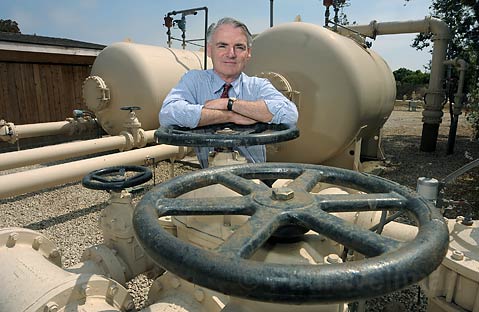
Charles Hamilton: The Renaissance Man
(Carpinteria Water District General Manager)
With a diverse educational background and a number of jobs adorning his curriculum vitae over the past 30 years, Charles Hamilton brings a unique perspective to the cadre of South Coast water managers. After receiving a bachelor’s degree in history at Kalamazoo College and a master’s in international affairs from the University of Pittsburgh, he went on to work for the Pittsburgh Public Schools, the Library of Congress, and the Boston Mayor’s Office as the senior administrative analyst before migrating to San Diego in 1981 to fill another city management position. However, the job fell through, and he found himself working at the Mesa Consolidated Water District in Orange County. “It all came together when I realized that I wanted to make a career in public service,” he said. “As I became familiar with water board operations, I found that it was where I wanted to stay.”
Hamilton has now been the general manager of the Carpinteria Water District for the past 13 years, and he has faced a number of challenges during his tenure there. “The main challenge has been working through rate increases associated with the addition of state water in 1991,” he explained. “We’ve had to raise our rates pretty high pretty fast because of that, and that was compounded because we had to make some profound improvements in water quality.” He also noted that the approach for dealing with problems such as water quality never remains static, and the effects of older ways of treating water-such as with disinfectant chemicals-is now being seen as a problem. “It’s very complicated and difficult to explain to the public,” he said.
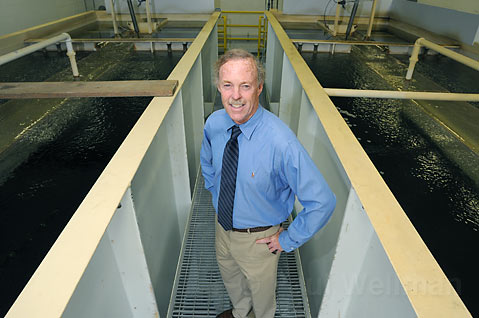
Tom Mosby: Giving Back
(Montecito Water District General Manager)
Moseby moved to Montecito when he was 13 years old, and is no stranger to the strange land of Montecito. “I had a lot of fun here as a kid, and it’s good to work in the community I grew up in and give back,” he said. Starting as an engineer and working his way up to general manager, he has been at the Montecito Water District for 18 years. “Water supply seems always to be at the forefront. It’s not a stable commodity,” he said. He contended that although there are an abundance of issues to work through, working with the board and with the other districts has been an enjoyable experience.
Recently, however, the future of the water resources available to Montecito-a thin slice of land sandwiched between the mountains and the ocean that has little capacity for its own water and the highest average consumption rates on the South Coast-has become a more contentious issue. “The attitude has been, ‘Find more water,’ but we need to learn to work with our existing water supply,” he said. As he has been heard saying at board meetings of late, Mosby is committed to moving his customers toward a more conservation-minded ethic, evidenced by the new inclined block rate structure, which penalizes excessive water use with higher rates. “There are many people who are very conservation oriented, but there are some folks who are busy and haven’t heard our requests for them to curb consumption,” Mosby said.
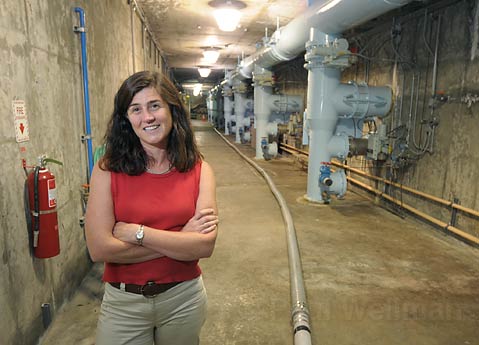
Rebecca Bjork: Crystal Falls in the Emerald City
(City of Santa Barbara Water Resources Manager)
“I think Santa Barbara is a great place to work because we’re so proactive about water conservation,” said Rebecca Bjork, who, after 11 months as the water resources manager, is the newbie among her peers. At board meetings all over the South Coast, the City of Santa Barbara Water Resources Department continually is mentioned as a model of success, having maintained the inclined block rate structure established in response to the drought of the late ’80s and early ’90s. The policies of Santa Barbara’s water works tend to reflect the city’s reputation as a green municipality. After all, Bjork’s department was the originator of the 20 Gallon Challenge-an effort to get customers to reduce their monthly water usage.
With a long-term water supply plan in place, Bjork said the only major challenges she faces are mitigating the effects of the silt and sediment from last year’s Zaca Fire on water quality and examining the possibility of bringing back online the decommissioned desalinization plant. “If we continue to rely on the public’s cooperation in water conservation, we have a pretty good outlook on water supply. In the event that we went into extreme drought, we would rely on desal,” Bjork explained. Bjork majored in environmental studies in college, and is focused not only on immediate water supply issues, but the underlying causes for shortage as well. “The real question is what’s happening with global climate,” she noted.
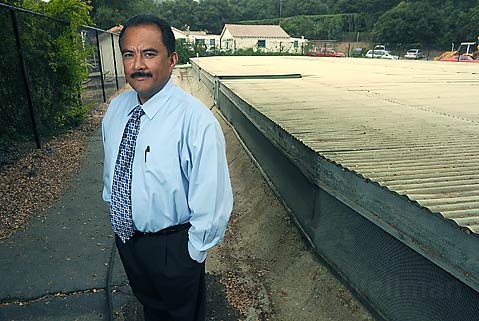
Mike Alvarado: Small Agency, Big Responsibility
(La Cumbre Mutual Water Company General Manager)
A true local son, Mike Alvarado is a third-generation Santa Barbaran who grew up on the Westside. “I was born and raised in Santa Barbara, so I always wanted to do something for the community,” he explained. Beginning his career nearly a quarter-century ago on a distribution crew with the City of Santa Barbara’s Water Resources Department, Alvarado made his way to the top by taking classes at Santa Barbara City College and slowly climbing the ladder. He’s been the manager at La Cumbre Mutual Water Company, which supplies water to homes in Hope Ranch, for two years now, and faces a number of challenges in a locale with limited water supply options.
“For a small mutual water company, there’s a lot involved,” he said, explaining that there are many water companies of a similar type that only deal with a few residences. “We deal with the State Water Project, and that’s the majority of our program.” While the average consumption rates of Hope Ranch customers are not quite as high as those in the Montecito Water District, they are still very high by area standards, but with fewer choices for water supply. Alvarado was able to negotiate a supply transfer from the City of Santa Barbara, but the 20 Gallon Challenge and other conservation measures are also being examined. “We’re talking right now about adopting an inclined rate structure, and if that doesn’t work, we’ll have to go into a rationing-type mode : as a last resort. Right now we’re in good standing, but next year it’s going to be difficult to meet our customers’ demand,” Alvarado said.
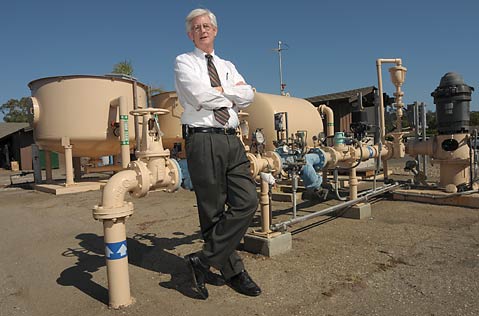
Kevin Walsh: Blood Is Thicker than Water
(Goleta Water District General Manager)
In a district that can be one of the most political at times, Kevin Walsh, who recently retired from his position as general manager, brought a lot of experience to the table. The son of an engineer who was the chief of the Division of Water Rights for the State Water Board, he began working as an engineer with the Orange County Sanitation District as soon as he got his engineering degree from UC Davis. “I went from one end of the pipe to the other,” he said of the jump to his position in the engineering department at the Goleta Water District in 1981.
Although he left in 1990 to serve as general manager at water districts in Monterey and San Diego counties, he was back in Goleta by 1997, this time as the agency’s operational head. “When I came, we were still under the shadow of the moratorium [of the late ’80s and early ’90s],” Walsh said. “There was a lot of deferred maintenance, and we had to get ourselves out of the hole that had been created by the moratorium. The challenge was getting our facilities ready for the 21st century so we could supply the community [with] quality water at a reasonable cost.” Walsh said that in his view, he has achieved that goal and set up his replacement for success. For his part, Walsh looks forward to spending more time with his wife and the four of his six sons who still live at home. One of the sons who has already flown the coop appears to have followed in his dad’s footsteps and has begun a career in engineering.
The Goleta Water District’s board of directors will hire a new general manager in the coming months. In the meantime, the district’s chief financial officer, Eric Ford, will serve as the interim general manager. “I’m the CFO and still have to perform those duties,” he said, noting that he’s been a lot busier since he agreed to shoulder the new responsibilities. Ford said he isn’t sure if he will apply for the full-time position. A consultant hired by the district is searching for qualified candidates.
Pay rates for all of the general managers of the South Coast’s water agencies are all in the neighborhood of $150,000, but all of them agree that the job can be rewarding in other ways. Serving the community, working with supportive staff, and mutual cooperation with other water districts were things listed by all five managers as perks of the job. Alvarado summed it up best, saying, “There are always people who don’t like what you’re doing, but it’s good to serve the community.”



